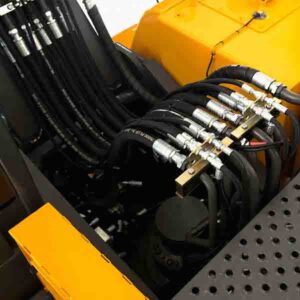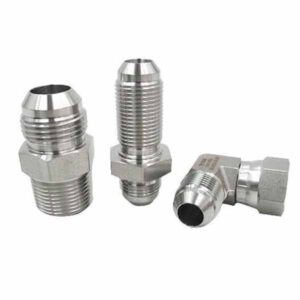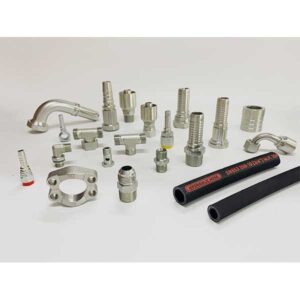Гідраўлічная арматура сустракаюцца ва ўсіх галінах прамысловасці і маюць шырокі спектр прымянення. Яны дапамагаюць кантраляваць і накіроўваць паток гідраўлічнага алею ўнутры гідраўлічныя шлангі, прадухіляць уцечкі і падтрымліваць ціск.
Вывучыце асновы гідраўлічных фітынгаў, каб выбраць найлепшы для вашай гідраўлічнай сістэмы. Канструкцыі фітынгаў пастаянна ўдасканальваюцца, каб адпавядаць стандартам бяспекі і прадукцыйнасці; вельмі важна быць знаёмым з розныя тыпы гідраўлічных фітынгаў выбраць найлепшы варыянт у залежнасці ад патрабаванняў да вашага прымянення, памеру шланга і спосабу зборкі. Розныя тыпы фітынгаў прызначаны для розных ужыванняў і спецыфікацый.
У гэтым артыкуле будуць разгледжаны азначэнне, прымяненне і найбольш распаўсюджаныя тыпы, формы і матэрыялы фітынгаў для гідраўлічных шлангаў. Разуменне гэтых асноўных тыпаў фітынгаў дапаможа вам прымаць абгрунтаваныя рашэнні пры выбары патрэбных фітынгаў для вашай гідраўлічнай сістэмы.
Што такое фітынг для гідраўлічнага шланга?
Высокаякасныя прамысловыя гідраўлічныя фітынгі для шлангаў з'яўляюцца важным кампанентам любой гідраўлічнай сістэмы. Фітынгі дазваляюць падключаць гідраўлічныя шлангі да розных кампанентаў і машын, а таксама палягчаюць перадачу гідраўлічнага алею і магутнасці.
Гідраўлічныя фітынгі бываюць розных памераў, матэрыялаў, тыпаў ушчыльненняў, а таксама класаў устойлівасці да тэмпературы і ціску. Некаторыя муфты дазваляюць цячы вадкасці, некаторыя перашкаджаюць, а некаторыя робяць і тое, і другое.

Якое прымяненне маюць прамысловыя гідраўлічныя фітынгі для шлангаў?
Дзякуючы шырокаму спектру прымянення прамысловых гідраўлічных шлангавых фітынгаў, яны могуць выкарыстоўвацца ў розных галінах прамысловасці. Да гэтых галін прамысловасці адносяцца:
Будаўніцтва і цяжкая тэхніка: Гідраўлічныя шлангавыя фітынгі забяспечваюць надзейную перадачу вадкасці і магутнасці ў гідраўлічных сістэмах экскаватараў, пагрузчыкаў і кранаў, што дазваляе дакладна кіраваць і эфектыўна працаваць.
Вытворчае і прамысловае абсталяванне: Станкі, прэсы і абсталяванне для апрацоўкі матэрыялаў — усе яны патрабуюць гідраўлічных шлангаў для забеспячэння бесперабойнай працы і мінімізацыі часу прастою.
Сельская гаспадарка: Гідраўлічныя шлангі эфектыўна перадаюць магутнасць і вадкасць у трактарах, камбайнах і ірыгацыйных сістэмах, палягчаючы пад'ём, кіраванне і кантроль навяснога абсталявання.
Транспарт і аўтамабілі: Ад легкавых аўтамабіляў да цяжкіх грузавікоў, гідраўлічныя муфты шырока выкарыстоўваюцца ў тармазных сістэмах, сістэмах рулявога кіравання з гідраўзмацняльнікам, сістэмах падвескі і гідраўлічных пад'ёмніках, сярод іншага.
Нафта і газ: Гэтая галіна выкарыстоўвае гідраўлічныя шлангавыя фітынгі для свідравання, здабычы і транспарціроўкі, забяспечваючы перадачу і кантроль вадкасці ў складаных умовах.

Распаўсюджаныя тыпы прамысловых гідраўлічных шлангавых фітынгаў
Існуюць тры асноўныя тыпы гідраўлічных муфт для шлангаў: з ушчыльняльным кольцам, вуглавыя злучэнні і з канічнай разьбой. Іншыя тыпы фітынгаў выкарыстоўваюцца для розных спецыяльных ужыванняў, але гэтыя тры з'яўляюцца найбольш распаўсюджанымі.
Ушчыльняльнае кольца з ушчыльняльнікам (ORFS)
Ушчыльняльны фітынг ORFS абсталяваны ўшчыльняльным кольцам на сваёй плоскай паверхні. Герметычнасць дасягаецца шляхам злучэння ўшчыльняльнага кольца з плоскасцю раздыма.
Ушчыльняльныя фітынгі ORFS — ідэальны выбар для прымянення пад высокім ціскам, яны забяспечваюць безуцечныя злучэнні. Яны бяспечныя і надзейныя, могуць ліквідаваць уцечкі ў гідраўлічных сістэмах з ціскам да 6000 PSI. ORFS звычайна пераважней, таму што яны менш схільныя да праблем з празмерным або недастатковым зацягваннем.

Спалучаны вугал
Гэтыя фітынгі маюць разьбу, а пасля разьбы ідзе вуглавая плоскасць (або кануснасць), якая ахінае ўвесь фітынг, вядомая як «развальцовка». Разьба можа быць прамой або паралельнай.
Сама разьба не ўтварае ўшчыльнення; замест гэтага яе функцыя заключаецца ў тым, каб злучыць канцы разьбы разам. Калі вонкавая і ўнутраная разьбы злучаюцца, развальцовкі сустракаюцца і «сядаюць» або герметызуюцца разам.

Канічныя разьбы
У канічным разьбовым фітынгу разьба мужчынскага раздыма знаходзіцца звонку, а разьба жаночага раздыма — унутры. Калі абодва раздымы злучаюцца разам, канічная разьба дэфармуецца. Узніклы ціск на муфты стварае ўшчыльненне.
Пад высокім ціскам вадкасць можа з часам пранікаць праз разьбу і спіральна рухацца ўздоўж яе, пакуль не знойдзе выхад. Нягледзячы на тое, што для прадухілення гэтага можна выкарыстоўваць сантэхнічную стужку, яна схільная да разрываў і забруджвання адчувальных участкаў. Канічная разьба таксама схільная да празмернага зацягвання. Гэтыя недахопы звычайна прыводзяць да забароны выкарыстання канічнай разьбы ў гідраўлічных і пнеўматычных сістэмах.

Якія іншыя гідраўлічныя злучэнні?
Улічваючы, што прамысловае абсталяванне і машыны распрацоўваюцца і вырабляюцца вытворцамі з усяго свету, не дзіўна, што існуюць розныя тыпы фітынгаў і адаптараў. Гэтыя розныя злучальнікі выкарыстоўваюць розныя метады ўшчыльнення і формы разьбы. Нягледзячы на тое, што многія з іх могуць выглядаць аднолькава або, прынамсі, вельмі падобнымі, дакладна вызначыць іх тыпы нескладана. Акрамя трох вышэйзгаданых, ёсць таксама наступныя варыянты на выбар.
- 37-градусны ўсплёск
- 30-градусны размах (метрычныя адзінкі)
- 45-градусны ўсплёск
- 24 градусы без выбліскаў (SAE)
- 24 градусы без размаху (DIN)
- 30-градусны размах (BSPP)
- Ушчыльняльнае кольца (ORFS)
- Паварот NPSM на 60 градусаў
- Конус 60 градусаў (BSPP)
- Конус 60 градусаў (метрычныя адзінкі)
Каб вызначыць тып фітынгаў, з якімі вы працуеце, выканайце просты чатырохэтапны працэс. Спачатку вам трэба высветліць, ці гэта пастаянныя фітынгі, ці шматразовыя. Пастаянныя фітынгі звычайна злучаюцца абціскам. У параўнанні з шматразовымі фітынгамі, пастаянныя фітынгі лягчэй і хутчэй мацуюцца, што робіць іх ідэальнымі для прымянення ў гідраўлічнай прамысловасці. Далей, перад тым, як спрабаваць усталяваць шланг або трубку, вам трэба вызначыць злучэнні портаў, якія пералічаны вышэй. Затым вам трэба вызначыць канкрэтны метад герметызацыі, які звычайна з'яўляецца аўтаматычным вуглавым герметызацыяй, канічнай разьбой або герметызацыяй з дапамогай ушчыльняльнага кольца. Пасля вызначэння метаду герметызацыі вам трэба выкарыстоўваць калібр для вызначэння вугла герметызацыі. Нарэшце, вам трэба вымераць разьбу, для чаго патрабуецца выкарыстанне штангенцыркуля. Вымераўшы колькасць разьб на цалю на вонкавым і ўнутраным дыяметрах, вы можаце дакладна прачытаць памер разьбы. Пасля таго, як вы дакладна ведаеце, якія фітынгі вы выкарыстоўваеце, вы можаце лёгка звязацца з пастаўшчыком і заказаць канкрэтны тып фітынгаў.
Разгледзьце іншыя характарыстыкі фітынгаў для гідраўлічных шлангаў
Іншымі важнымі асаблівасцямі гідраўлічных шлангавых фітынгаў з'яўляюцца тое, як яны мацуюцца да шланга, іх форма і матэрыялы, з якіх яны выраблены.
Пастаянны тып абціскання і тып шматразовага выкарыстання ў палявых умовах
Гідраўлічныя фітынгі можна падключыць да гідраўлічных шлангаў двума асноўнымі спосабамі: абціскныя фітынгі і фітынгі, якія прымацоўваюцца ў палявых умовах.
The Фітынгі, якія можна прымацаваць на месцы або шматразова выкарыстоўваць пастаўляюцца з разеткамі і ніпелямі і могуць быць лёгка ўстаноўлены ў любым месцы без неабходнасці выкарыстання абціскальнага абсталявання.
Абціскныя фітынгі назаўсёды герметызуюцца з дапамогай абціскальнай машыны. Пастаянныя гідраўлічныя фітынгі выкарыстоўваюцца часцей, чым шматразовыя. Яны вядомыя сваёй бяспекай і надзейнасцю і шырока ўжываюцца ў гідраўлічнай энергетыцы.
Пастаянныя прыстасаванні патрабуюць выкарыстання абціскнога станка. Існуе мноства тыпаў абціскных станкоў, ад вялікіх майстэрскіх станкоў да больш партатыўных ручных прылад. Партатыўныя абціскныя станкі сталі вельмі папулярнымі і падыходзяць для выкарыстання на месцы.
Форма
Форма фітынгаў гідраўлічных шлангаў дазваляе злучаць шланг і кампаненты, змяняць кірунак, а таксама падзяляць або аб'ядноўваць вадкасць. Вось некаторыя распаўсюджаныя формы прамысловых фітынгаў гідраўлічных шлангаў:
Прамыя фітынгі: Гэта самы просты тып фітынгаў для шлангаў. Ён мае прамую канструкцыю і выкарыстоўваецца для злучэння двух шлангаў па прамой лініі або для падлучэння шланга да кампанента.
Каленападобныя фітынгі: Гэтыя фітынгі маюць выгнутую або вуглавую канструкцыю і выкарыстоўваюцца, калі неабходна змяніць кірунак вадкасці ў гідраўлічнай сістэме. Каленныя фітынгі бываюць розных вуглоў, такіх як 45 градусаў і 90 градусаў, што забяспечвае большую гнуткасць пры праектаванні і мантажы сістэмы.
Трайнікавыя фітынгі:Тройнік мае форму літары Т і выкарыстоўваецца для падзелу або аб'яднання патоку гідраўлічнага алею. Ён можа злучаць тры шлангі або кампаненты, тым самым дасягаючы разгалінавання або аб'яднання гідраўлічнай лініі.
Папярочная арматура: Папярочныя фітынгі падобныя да трайніка і маюць крыжападобную канструкцыю. Яны могуць злучаць чатыры шлангі або кампаненты, што дазваляе ствараць больш складаныя канфігурацыі гідраўлічных сістэм.
Фланцавыя фітынгі: Гэтыя фітынгі выкарыстоўваюцца для падлучэння шлангаў або кампанентаў да паверхні фланца. Яны забяспечваюць надзейнае і герметычнае злучэнне, што робіць іх прыдатнымі для выкарыстання пад высокім ціскам.
Чаму існуе так шмат розных тыпаў гідраўлічных фітынгаў?
Нягледзячы на тое, што існуе мноства тыпаў гідраўлічных фітынгаў і раздымаў, іх можна ў цэлым падзяліць на тры асноўныя тыпы: металічныя ўшчыльняльнікі, мяккія ўшчыльняльнікі і канічныя разьбовыя раздымы.
Незалежна ад таго, да якога тыпу належаць вашы фітынгі, яны павінны адпавядаць двум умовам: яны павінны герметызаваць і павінны трымацца. У некаторых выпадках адзін і той жа механізм можа выконваць абедзве функцыі; у іншых выпадках за гэтыя дзве функцыі адказваюць дзве розныя часткі аднаго і таго ж механізму адпаведна. Кануснасць канічнага злучальніка трубы выразаецца на канусе з дыяметрам трубы і паступова змяняецца ўздоўж усёй разьбовай часткі трубы, каб зрабіць злучэнне больш надзейным. Такія фітынгі патрабуюць выкарыстання герметыкаў, каб гарантаваць адсутнасць уцечак вакол фітынгаў, і звычайна выкарыстоўваюцца хімічныя герметыкі або герметычныя стужкі. Нягледзячы на тое, што правільная ўстаноўка канічнай трубной разьбы можа быць даволі складанай, гэта вельмі важна, таму што дрэнная герметызацыя можа прывесці да ўцечкі пры ўжыванні ціску. Недахопам канічных фітынгаў для труб з'яўляецца тое, што падчас злучэння іх неабходна мацаваць да трубы з дапамогай зваркі або пайкі.
Вынаходніцтва металічных герметычных фітынгаў было ў асноўным накіравана на замену канічных фітынгаў з трубаправоднай разьбой. Гэты тып фітынгаў выкарыстоўвае канічную разьбу ў спалучэнні з апрацаванымі тарцамі, якія могуць вытрымліваць высокі ціск, які звычайна сустракаецца ў гідраўлічных сістэмах. Разьба адказвае за падтрыманне сілы злучэння, а апрацаваны тарцавы паверхня — за герметызацыю. У параўнанні з канічнымі фітынгамі, металічныя герметычныя фітынгі лягчэй размяшчаць і звычайна не патрабуюць дадатковых герметыкаў для забеспячэння лепшай герметычнасці. Аднак іх усё роўна трэба прыварваць або прыпайваць да трубы.
Фітынгі з мяккім ушчыльненнем, верагодна, з'яўляюцца найбольш распаўсюджаным тыпам. У іх выкарыстоўваюцца эластычныя ўшчыльняльнікі корпуса, якія могуць прадухіліць уцечку нават ва ўмовах высокага ціску. Адной з галоўных пераваг выкарыстання фітынгаў з мяккім ушчыльненнем з'яўляецца вельмі высокая хуткасць усталёўкі, што асабліва важна ў прамысловых умовах. Акрамя таго, яны могуць вытрымліваць шматлікія вібрацыі, з якімі сутыкаюцца сістэмы, таму ўзровень паломак значна ніжэйшы, чым у канічных фітынгаў.
Выберыце патрэбны гідраўлічны шланг для вашага прымянення
Прамысловыя гідраўлічныя фітынгі для шлангаў з'яўляюцца неад'емнай часткай розных гідраўлічных сістэм. Разуменне розных тыпаў фітынгаў, іх матэрыялаў і тыповых ужыванняў мае вырашальнае значэнне для выбару правільных фітынгаў, якія адпавядаюць вашым канкрэтным патрэбам. Выбар правільных фітынгаў забяспечвае бяспечную і эфектыўную працу гідраўлічнай сістэмы, мінімізуе час прастою і павышае эфектыўнасць вытворчасці.
Пры выбары падыходнага фітынга для гідраўлічнага шланга найважнейшымі фактарамі з'яўляюцца памер, матэрыял, дыяпазон тэмператур і патрабаванні да ціску. Варта таксама ўлічваць канкрэтнае прымяненне і функцыю фітынга. Нарэшце, калі фітынгі неабходна часта падключаць і адключаць, варта выбіраць фітынгі, якія лёгка збіраць і разбіраць.

Прадукты і паслугі Sinopulse па фітынгу гідраўлічных шлангаў
Sinopulse прапануе высокую якасць вырабы з фітынгаў для гідраўлічных шлангаў і першакласны сэрвіс. У нас ёсць на складе прамысловых гідраўлічных шлангаў, фітынгаў і муфт коштам больш за адзін мільён долараў ЗША, а таксама 200 вытворчых станкоў з ЧПУ для фітынгаў, з гадавой вытворчай магутнасцю больш за дзесяць мільёнаў гідраўлічных фітынгаў, што гарантуе, што ўсё неабходнае заўсёды будзе ў наяўнасці.
Наша фабрыка можа выканаць любыя нестандартныя зборкі шлангаў у адпаведнасці з вашымі канкрэтнымі патрабаваннямі. Мы можам дапамагчы вам у праектаванні і стварэнні бяспечнай і эфектыўнай гідраўлічнай сістэмы, якая адпавядае вашым патрэбам.
Калі вы хочаце даведацца больш пра фітынгі для гідраўлічных шлангаў, паслугі завода па вытворчасці шлангаў і абціскальнае абсталяванне, калі ласка звяжыцеся з наміВы таксама можаце непасрэдна купіць фітынгі і вырабы для гідраўлічных шлангаў па адрасе https://www.sinopulse.cn/!